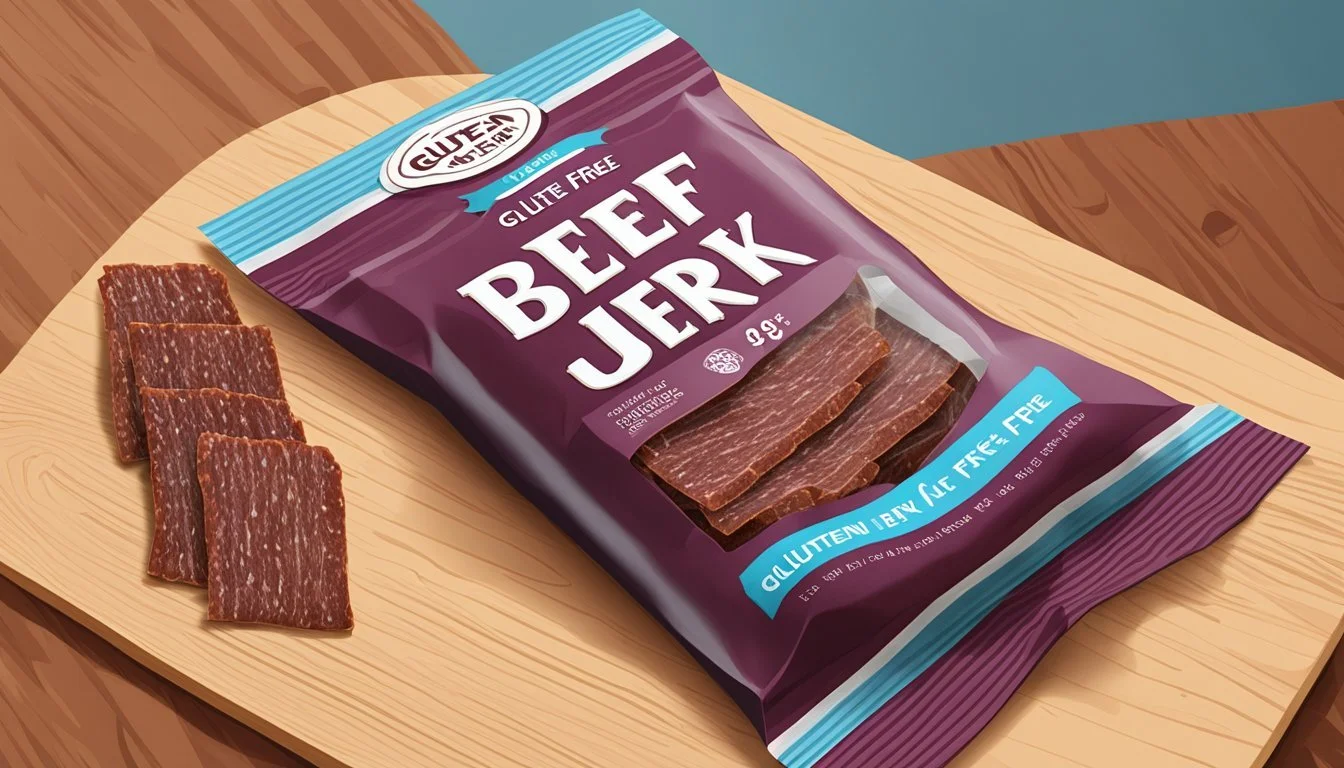Is Beef Jerky Gluten-Free?
Understanding its Ingredients and Processing
Beef jerky, a portable high-protein snack, has long been popular among those looking for a convenient and nutritious option to curb hunger on the go. Traditionally, beef jerky is made by cooking and dehydrating strips of beef, a process that inherently does not include gluten-containing ingredients. However, many commercial beef jerky products incorporate additional flavorings, seasonings, and marinades, which can introduce gluten into the final product.
Consumers seeking gluten-free options, perhaps due to celiac disease, wheat allergies, or non-celiac gluten sensitivity, must scrutinize product labels and ingredient lists closely. Gluten-free diets exclude all forms of wheat, barley, and rye, making it essential for those affected to identify jerky brands that specifically cater to their needs. Fortunately, with the rising demand for gluten-free products, several brands have stepped up to offer beef jerky that is safe for gluten-sensitive individuals, often highlighting their gluten-free status on packaging.
It is essential for individuals adhering to a gluten-free lifestyle to note that while some beef jerky brands ensure a gluten-free product by avoiding gluten-containing additives, others have obtained certifications verifying that their products meet stringent gluten-free standards. These certifications can provide an added layer of confidence for consumers in search of safe, gluten-free protein snacks.
What Is Beef Jerky?
Beef jerky is a popular snack known for its rich flavor and long shelf life. It consists of lean cuts of beef that have been trimmed of fat, cut into strips, and then dried to prevent spoilage. The dehydration process involves the use of salt, which serves as a natural preservative. This snack is renowned for its portability and high-protein content, making it a favored choice among outdoor enthusiasts, athletes, and anyone seeking a nutritious, on-the-go option.
Ingredients: Beef jerky’s key ingredient is, of course, beef. However, its distinct taste and texture result from the combination of various other components. Here are the fundamental ingredients:
Beef: Lean cuts to ensure a high-quality end product.
Salt: Crucial for both flavor and preservation.
Flavorings: Ranging from simple black pepper to complex spice blends, adding to the jerky's appeal.
Other ingredients often include soy sauce, vinegar, or smoke flavoring to enhance its savoriness and create a range of flavors from smoky to spicy or sweet.
Flavors: A variety of flavor profiles can be achieved by marinating the beef strips in different seasonings. Below is an illustration of common flavors available:
Classic: Highlighted by a simple salt and black pepper marinade.
Sweet: Often involves honey or brown sugar.
Spicy: Could include chili peppers, cayenne, or jalapeño.
Teriyaki: Infused with a sweet and tangy soy sauce-based marinade.
Beef jerky’s versatility in flavors and ingredients has solidified its status as a tried-and-true snack for people seeking a tasty, high-protein treat.
Understanding Gluten
Gluten is a group of proteins found primarily in wheat, barley, and rye. It acts as a binder that holds food together and can provide a chewy texture. Gluten is prevalent in many food products, which can complicate dietary needs for individuals with gluten-related disorders.
Those sensitive to gluten may experience adverse reactions, including celiac disease, gluten intolerance, or gluten sensitivity. Celiac disease is an autoimmune disorder where the ingestion of gluten leads to damage in the small intestine. Gluten intolerance, while not an autoimmune disease, may cause discomfort without causing lasting intestinal damage. Gluten sensitivity's symptoms may resemble celiac disease but lack the same level of intestinal inflammation or damage.
It is critical for individuals with these conditions to avoid gluten-containing products to maintain their health. Foods and products that are gluten-free are essential for these individuals to avoid symptoms, which may include gastrointestinal distress, headaches, fatigue, and skin issues, among others.
Gluten-Containing Grains Gluten-Free Alternatives Wheat Rice Barley Corn Rye Quinoa
When it comes to processed foods like beef jerky, it becomes especially important to read labels carefully since gluten can be present in marinades, fillings, or flavorings used during production. Ensuring that beef jerky is labeled as "gluten-free" is a necessary precaution to avoid inadvertent consumption of gluten.
Is Beef Jerky Gluten-Free?
When one is considering whether beef jerky is gluten-free, attention should be paid not just to the core ingredients but also to seasonings, marinades, and potential sources of cross-contamination. Gluten presence in beef jerky is dependent on several factors from the ingredients used in flavoring to the production process.
Gluten-Containing Ingredients in Beef Jerky
Beef jerky's traditional ingredients, like beef, salt, and smoke, are inherently gluten-free. However, many brands incorporate soy sauce, teriyaki sauce, malt, and other flavorings which often contain gluten. Elements derived from wheat, barley, or any wheat by-products are likely to contain this protein, altering the gluten-free nature of the jerky.
Reading Labels for Hidden Gluten
Consumers must scrutinize the ingredient list on the product label for any gluten-containing condiments or additives. It is crucial to look for terms indicating gluten such as wheat, barley, rye, oats, or malt. Labels might also list items like 'natural flavors' or 'seasoning' which could be sources of hidden gluten.
Gluten-Free Certification
For assurance, shoppers should seek out products with a gluten-free certification from a reputable organization. This certification confirms that the product has met stringent guidelines set by a third-party certification body and is safe for those following a gluten-free diet. Certifications commonly appear on the product packaging.
Cross-Contamination Risks
Even if all ingredients are gluten-free, cross-contamination is a risk during production, particularly in facilities processing both gluten-free and gluten-containing products. It's important to verify if the jerky has been produced in a dedicated gluten-free facility to prevent contact with gluten, which could cause symptoms in individuals with a wheat allergy or celiac disease affecting their small intestine.
Health Benefits and Risks
When considering beef jerky as a snack choice, the question of whether it suits a gluten-free diet is imperative, especially for those with celiac disease or gluten intolerance. This section breaks down the health benefits of gluten-free beef jerky alongside the potential risks associated with preservatives and additives found in some products.
Benefits of Gluten-Free Beef Jerky
Gluten-Free Diet Compatibility: Gluten-free beef jerky aligns with the dietary restrictions of individuals with celiac disease or gluten intolerance, eliminating the risk of digestive issues, skin rashes, and brain fog that can accompany gluten ingestion.
High Protein Content: As a rich source of protein, gluten-free beef jerky aids in muscle repair and maintenance, making it a satisfying snack that can help curb hunger between meals.
Low Carbohydrate Option: Those monitoring carbohydrate intake may find gluten-free jerky an attractive low-carb choice.
Nutritional Profiles: Often low in fat, gluten-free beef jerky offers a lean snacking option.
Potential Risks and Considerations
Presence of Additives: Despite being gluten-free, some beef jerky might contain additives like monosodium glutamate (MSG) or preservatives such as sodium nitrite, which can pose health risks when consumed in large quantities.
Sodium Content: Many beef jerky products are high in sodium, which can contribute to increased blood pressure and other cardiovascular risks if consumed excessively.
Allergen Awareness: Policing for other allergens, such as soy, is crucial for those with additional sensitivities.
Choosing Gluten-Free Jerky Brands
When selecting a gluten-free jerky brand, consumers should look for clear labeling that certifies the products are without gluten. Brands that cater to gluten-free diets typically take measures to ensure there is no cross-contamination during the manufacturing process. Here is a list of several reputable gluten-free beef jerky manufacturers:
People's Choice: This brand offers a range of beef jerky options, including Carne Seca and Old-Fashioned Original, which are suitable for those avoiding gluten.
The New Primal: Known for their commitment to natural ingredients, The New Primal's beef jerky is free from gluten, artificial ingredients, and preservatives.
Baja Jerky: Baja Vida provides a selection of gluten-free jerky choices, maintaining a focus on flavorful and gluten-free snacking.
Stryve - This brand offers gluten-free, grain-free, and non-GMO biltong, which is a type of dried, cured meat that comes in various flavors and boasts high protein content.
Righteous Felon: With an assortment of gluten-free flavors, Righteous Felon jerky is a go-to choice for many looking for premium, craft gluten-free options.
Topanga's Finest: They ensure that all their jerky, including chicken, beef, and bacon jerky, is 100% gluten-free, catering especially to those with Celiac Disease or gluten sensitivity.
Krave: Known for gourmet flavors, Krave's formulations are crafted to be gluten-free, making it a suitable brand for those on a gluten-free regimen.
Epic: Specializing in meat-based snacks that are both tasty and gluten-free, Epic makes various meat bars and jerky bites that comply with gluten-free standards.
When browsing jerky brands, consumers should always read the ingredient list and nutrition labels to verify the absence of gluten or any potential cross-contaminants. It is also advisable to look for certifications or claims on the packaging that indicate the product is tested and recognized as gluten-free.
Making Your Own Gluten-Free Beef Jerky
Creating gluten-free beef jerky is a straightforward process that requires selecting quality ingredients and using proper cooking techniques. Choosing the right cut of beef, preparing gluten-free marinades, and utilizing the correct cooking methods ensures a safe and savory snack for those with gluten sensitivities.
Selecting the Right Cut of Beef
For the best homemade beef jerky, one should opt for 100% grass-fed beef to ensure a natural and rich flavor. The preferred cuts are lean ones such as top round, eye of round, or sirloin tip. These cuts have minimal fat, which is ideal since fat does not dehydrate well and can cause the jerky to spoil faster. One should slice the beef thinly, about 1/8-inch to 1/4-inch thickness, against the grain to improve texture and ease of eating.
Gluten-Free Marinades and Seasonings
Marinades and seasonings are imperative for flavor and ensuring the jerky is gluten-free. Here's an example of a gluten-free marinade recipe:
1/2 cup of gluten-free tamari or soy sauce
2 tablespoons of brown sugar or a sugar-free alternative for sweetness
1/2 teaspoon each of granulated garlic and granulated onion
1/2 teaspoon of black pepper
Optional: a pinch of chili flakes or a small amount of hot sauce, ensuring it's gluten-free
It's essential to avoid ingredients like traditional soy sauce, teriyaki sauce, and certain marinades that often contain gluten. Alternatively, one can create a simple mixture of gluten-free tamari, garlic, spices, and vinegar. Always marinate the sliced beef for several hours or overnight to allow the flavors to penetrate deeply.
Cooking Methods
To cook beef jerky, one can use either an oven or a dehydrator.
Using an oven:
Preheat to the lowest setting, typically between 170°F to 200°F.
Arrange the marinated beef slices on a wire rack over a baking sheet to allow airflow and catch drips.
Bake until the beef is dry and chewy, usually for 3 to 8 hours, depending on thickness.
Using a dehydrator:
Place the marinated beef strips on the dehydrator trays without overlapping.
Follow the dehydrator's instructions, usually dehydrating at 165°F for 4 to 6 hours.
For both methods, it is essential to ensure the jerky is properly dried to prevent spoilage. The final product should be chewy but not brittle. Homemade jerkies lack preservatives like MSG and thus have a shorter shelf life, so they should be consumed within a few days or stored in a refrigerator.
Navigating a Gluten-Free Diet with Beef Jerky
For individuals with celiac disease or gluten intolerance, sticking to a gluten-free diet is crucial for their health. Beef jerky can be a convenient and reliable snack option, especially when traveling or in need of a quick protein boost. However, it is essential for them to be vigilant about the products they choose.
The basic components of beef jerky—beef, salt, and the smoking process—are inherently gluten-free. Some jerky brands have dedicated gluten-free product lines, ensuring their jerky contains no gluten and is produced in a facility free of cross-contamination risks.
Key Considerations:
Ingredients: Always check labels for additives like soy sauce or teriyaki sauce, as these can contain gluten.
Branding: Look for brands that explicitly state their product is gluten-free.
Cross-contamination: Select brands that use gluten-free facilities to minimize contamination risks.
Gluten-Free Beef Jerky Brands:
The New Primal
Baja Jerky
When purchasing beef jerky, opting for plain versions rather than flavored can often increase the likelihood of a gluten-free product. Those on a gluten-free diet should consider that "gluten-free" on the packaging doesn't always equate to 0% risk of gluten presence—it indicates that the product contains less than 20 parts per million of gluten, which is the threshold set by the FDA.
Tips for Safe Consumption:
Prior to travel, stock up on trusted gluten-free beef jerky to avoid limited choices on the go.
In the absence of labeled packaging, contact the manufacturer directly to inquire about their gluten-free processes.
By taking these steps, they can ensure their diet remains uncompromised while still enjoying the savory versatility of beef jerky.
The Market for Gluten-Free Beef Jerky
The demand for gluten-free products has risen substantially, including in the snack industry. Companies are increasingly acknowledging the needs of consumers with gluten sensitivities and are responding by producing gluten-free variations of popular products, such as beef jerky.
Gluten-Free Beef Jerky Brands: Many brands now offer gluten-free beef jerky, crafted to cater to both health-conscious individuals and those with celiac disease or gluten intolerance. Here are some notable brands in this expanding market:
The New Primal: Offers products that are devoid of artificial ingredients and added sugars.
Baja Jerky: Provides a selection of gluten-free beef jerky options, focusing on simple, clean ingredients.
People’s Choice: Features a variety of flavors, including Carne Seca and Old Fashioned jerky, tailored for gluten-free diets.
Righteous Felon: Known for their premium, craft jerky with multiple gluten-free flavors.
PREVAIL: Certified gluten-free beef jerky in flavors like umami and lemongrass, free of nuts and soy.
Ingredients and Considerations: When it comes to gluten-free jerky, the core ingredients of beef, salt, and sometimes smoke are naturally free from gluten. Nonetheless, additives such as soy sauce and teriyaki sauce often incorporated in traditional jerky can contain gluten.
In response to an expanding health-conscious consumer base, gluten-free jerky has become more accessible in mainstream retail stores and online platforms. Some producers even ensure their products are made in gluten-free certified facilities to prevent cross-contamination.
Plant-Based Alternatives: The jerky market also includes plant-based jerky options, which inherently do not contain gluten. These products appeal to vegetarians, vegans, and those seeking plant-based diet snacks.
In conclusion, the market for gluten-free beef jerky is vibrant and continues to adapt, offering a growing range of choices for consumers prioritizing both health and flavor.
Emerging Trends in Gluten-Free Jerky
The gluten-free jerky market has seen an innovative push towards diverse and exciting flavor profiles beyond the traditional savory options. Manufacturers are experimenting with flavors such as sweet orange and salsa fresca, aiming to satisfy a broader range of palates. Among these, churro-flavored jerky offers a novel sweet twist, while sriracha continues to provide that familiar spicy kick. Flavorings are carefully selected to ensure they are gluten-free and add complexity to the taste without compromising on dietary requirements.
In response to health-conscious consumers, many jerky brands now focus on providing non-GMO and natural ingredients. This trend extends to the types of jerky available, with biltong — a form of dried, cured meat that originated in South Africa — gaining popularity for its simple ingredient list and lack of preservatives.
Here is a breakdown of the key points:
Flavors: Expansion into both complex and simple flavors to cater to various preferences.
Health-Conscious: A noticeable shift toward non-GMO ingredients and minimally processed products.
Type Variety: Introduction of international types like biltong, alongside conventional beef sticks.
Innovation: Continuing to create products that maintain a gluten-free status while enhancing the consumer experience with creative twists on traditional jerky.
Brands are focusing on transparent labeling to reassure consumers that their offerings are genuinely gluten-free. This includes rigorous testing procedures and clear communication on packaging. The result is a growing variety of gluten-free jerky products that prioritize both safety and flavor.







